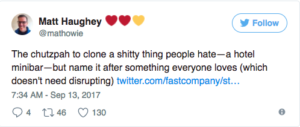An Interview with Katie Tamony
We sat down with Katie Tamony, Chief Communications and Culture Officer at Alluma, a technology non-profit dedicated to making sure those eligible for benefits and services don’t fall through the cracks. Katie talks to us about leading transformation projects: her role, why these kinds of projects excite her, and what’s critical in executing a transformation successfully.
This isn’t the first transformation project you’ve been a part of. Why does this kind of work appeal to you?
Building something new out of what has been has always excited me. That’s why I’m particularly interested in organizations that have an established track record, but, because of market forces or business demands, haven’t been able to sustain their success. They stop growing. Transformational work is a unique opportunity to think differently, question the sacred cows, and re-see the insights you took for granted. I just love discovering the hidden potential in people and in organizations.
You’ve led many rebrands. What role does brand play when a company is making a significant shift?
I see brand as the decision-making filter for the organization. It guides who you want to hire, what you offer customers, how you express yourself, how you make business decisions about what to invest in…it touches everything. It’s a roadmap; it’s guardrails. Brand ensures the organization is moving in the right direction. And I’ve found that when done right, brand can create a wonderful shared understanding within an organization of who you are and why you matter.
How did you work with leadership to create and maintain alignment throughout the transformation?
Any transformation is a journey, it’s a process. Setting goals and objectives at the beginning ensures that the leadership team is aligned around what success looks like from the start. But in my experience at Alluma and in leading past transformation at SFMOMA, Sunset Magazine, and Monrovia Plants, it’s beneficial to not just keep the brand journey within the executive team. For instance, at Alluma, we invited mid-level managers and other subject-matter experts to weigh in and help evaluate market insights when we were at a pivotal point in the process with Emotive Brand. Inviting other people outside of the executive leadership to sit around the table gave us true perspective on how ideas and insights were landing and what felt true to the people closest to the day-to-day work. Having them ideate the opportunities that would emerge if we went a certain direction was exciting and a real pressure test.
What about the board? Is there a role for them in projects like this?
As a non-profit, the role of the board is critical. They’re like a senior executive group, but at the same time they bring a lot of external perspective and deep knowledge for our sector that is indispensable. We got their buy-in on the goals and the process early on and involved them at key decision points. Choosing the final name for Alluma actually came down to decisions from the CEO and the Board.
These projects are long. How do you communicate to employees to keep them connected after the pivotal brand launch moment?
Yes, the launch is exciting. A new name. A new website. A new T-shirt. But then it’s kind of like after a wedding or any climatic event, people are thinking, “okay well, how does this change my day-to-day?” Then begins the most critical phase of the transformation; helping people figure out how they internalize the brand and start to use it to inform their own decision making, their everyday work. From how they show up to a meeting, how they sell, how they talk to our clients—all of these activities are influenced by the brand. It takes education, but I mostly think about using brand as an invitation to talk about things in a new way.
Did you see the culture ultimately change?
Behavior change drives culture change, and behavior change is challenging. It takes time. And it starts small. So it’s critical that even small behavior changes are recognized and reinforced. You want to encourage people to look for opportunities to reinforce the brand until it just feels natural. I see culture change as the final and most lasting element of transformation. It requires brand education, business focus, and even organizational change management.
What challenges might others find along the way they should be mindful of?
Every organization is unique. Alluma was my first time leading a brand transformation at a technology company. I learned that I had to invest time in using more data and visible, specific examples to back up emotional insights to get our engineers and developers (rational thinkers) to see that this was a serious approach to branding. That was a challenge I underestimated. Figuring out a way to define brand and translate it into both rational and emotional terms is key to get diverse stakeholders on board.
How do you measure success from a brand perspective? Business? Culture?
We measured success by the objectives we set at the beginning of the project. We conducted a baseline survey with our employees measuring current brand attributes, and then we will assess quarterly to measure alignment with the strategy, understanding of the strategy, how much they believe in it. From a business perspective, we looked at awareness and interest from our target audience. To measure, we looked at website traffic, newsletter subscriptions, social media engagements. We also evaluated brand against our revenue goals and, because we have a long business development process, that measurement is still ongoing. As for culture, I see people organically bringing more visible curiosity and a wider approach to problem-solving to all engagements. It’s just evident that the culture of tenacious problem solving is coming to life.
What do you see as the key to a successful transformation?
For one, the process is important. People may discount the process, but the journey is everything. That doesn’t mean it needs to be super long or really expensive. It just has to be thoughtful. And, I’d say again, go beyond your executive team. These kinds of projects can break down silos and barriers within an organization in an incredible way.
Alluma and Emotive Brand partnered to rebrand SIS to Alluma, transforming the brand, business, and culture. Read the case study here.
Emotive Brand is a brand strategy and design agency in Oakland California.










